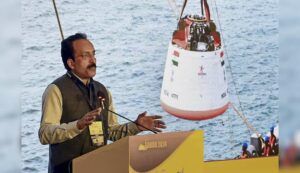
According to ISRO Chairman S. Somanath, the Indian Space Research Organization (ISRO) is getting ready for the January 2025 launch of the NVS-02 satellite on board the Geosynchronous Satellite Launch Vehicle (GSLV).

This mission is only one of several that are planned for the next year, the ISRO chairman noted on Monday. ISRO will launch the GSLV on its 100th mission.
“We have many missions in 2025, to start with the mission of GSLV launching the NVS-02 in the month of January,” Somanath remarked in reference to the impending mission.
The 2,232-kg NVS-01 satellite was successfully launched into Geosynchronous Transfer Orbit (GTO) on May 29, 2023, using the GSLV-F12 rocket.
The NVS-01 satellite was built to expand NavIC’s capabilities, including L1 band communications for wider service coverage, and it included an in-house atomic clock, according to an ISRO statement.
This development is probably going to continue with the NVS-02 mission, which will add more sophisticated functions to the NavIC system.
Following the successful launch of PSLV-C60, which carried the SpaDeX and other payloads, Somanath made the announcement.
Somanath emphasized the significance of docking for the Chandrayaan-4 mission after the launch, stating that the last docking is anticipated to take place on or around January 7 of next year.
The five components that make up Chandrayaan-4 would be launched at various dates and combined into two distinct modules, he said. After entering orbit, these modules must dock in both Earth’s and the Moon’s orbits. It is crucial for Chandrayaan-4 to dock. The goal of this mission is to go to the Moon, land there, come back to Earth, and successfully finish the voyage.
“This is one of the proving grounds for Chandrayaan-4,” he said. Although there will be a lot of procedures involved, the final docking is expected to occur by January 7. Docking will start tomorrow.
“For us, this is the 99th launch of any launch vehicle from the Satish Dhawan Space Centre,” Somanath said in celebration of ISRO’s 99th mission. It is a very important milestone. At the beginning of next year, we’re getting ready for the 100th launch. PSLV-C60 successfully launched two SpaDeX satellites, each weighing 220 kg, into a 475-kilometer circular orbit on its 99th mission.
He said that beginning tomorrow, SpaDeX will go through a number of procedures to get it ready for docking, with the last docking anticipated to take place on January 7, 2025. “This is not the first SpaDeX; there will be more varieties, including demonstrations of bigger and more complex versions of docking systems in the coming days,” he said.
On social media, Minister of State for Science and Technology Dr. Jitendra Singh also praised the mission’s accomplishments. He concluded, “Privileged to be associated with the Department of Space at a time when Team #ISRO mesmerizes the world with global wonders, one after the other.” Singh emphasized ISRO’s accomplishments in space exploration and its increasing international prominence.
Singh said, “India’s domestically created ‘Bharatiya Docking System’ makes it the fourth nation to join the exclusive group of countries pursuing space docking.” In the pursuit of a “Viksit Bharat,” this is a modest homage to Prime Minister Narendra Modi’s motto of “Atmanirbhar Bharat.” This accomplishment will open the door for next initiatives like “Gaganyaan” and “Bharatiya Antariksha Station.”
The historic goal of ISRO’s year-end project, the SpaDeX mission, is to accomplish the uncommon task of docking or combining two spacecraft in orbit. Using two tiny spacecraft launched by PSLV, the project is an economical technological demonstration mission for in-space docking.
The development and demonstration of the technology needed to rendezvous, dock, and undock two tiny spacecraft (SDX01, the Chaser, and SDX02, the Target) in low-Earth circular orbit is the main goal of the SpaDeX mission. For long-term projects like Chandrayaan-4, the future manned Gaganyaan mission, and the Indian space station, docking technology is essential.